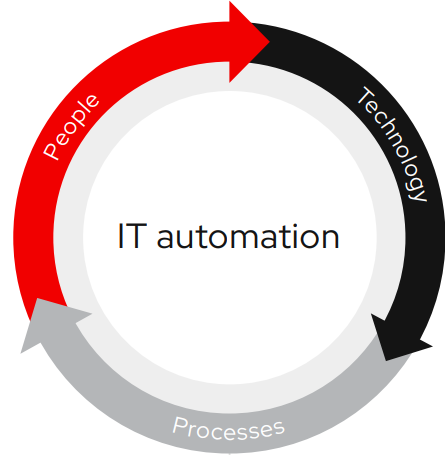An IT executive's guide to automation
Why you need to consider strategic automation
Organizations across industries face unprecedented pressure to deliver services with increased speed and hardened security practices.
IT teams play a crucial role in meeting these demands, but they need to be efficient and scalable to keep up with growing demands.
The solution is often found on one of two paths: hire more help or automate.
Due to talent shortages or budget restrictions, many organizations can’t expand their teams. Strategic IT automation can help your current workforce accomplish more to support business requirements.
Automation can help organizations achieve success. It allows them to take advantage of new opportunities by:
- Moving faster with improved resilience.
- Operating with more predictability and efficiency.
- Encouraging new ways of working.
- Responding immediately to changing conditions without staff intervention.
Digital transformation initiatives involve people, processes, and technology, so it’s important to understand how automation affects each of these elements.
- People: Improve morale by automating high-volume routine tasks and freeing time for more interesting and high-priority projects.
- Technology: Configure, manage, and operate components through automation.
- Processes: Streamline complex processes and build complete automated workflows.
Automation is critical for supporting modernization and digital transformation.
Strategic IT automation is the way to success in a digital world.
While many organizations have started automating, they often do so in a disparate, task-focused manner. A holistic, strategic approach is needed to support enterprise-wide automation that frees your organization to take advantage of the opportunities presented by emerging technologies like artificial intelligence (AI).
So what does mission-critical IT automation look like?
Implemented successfully, mission-critical IT automation can help your organization:
- Maximize return on your existing technology investments.
- Establish a resilient IT environment for the adoption of AI and other technologies.
- Optimize productivity and efficiency within IT teams.
- Resolve IT service tickets in less time.
- Coordinate workflows across your entire IT environment, including datacenters, clouds, operating systems, applications, networking, IT services, security systems, and edge devices.
- Adhere to internal governance policies and service-level agreements (SLAs).
- Proactively address potential issues and remediate security and compliance risks.
- Speed operations across users, teams, and regions.
Because of the wide-reaching value it can bring to an organization, strategic IT automation has shifted from a “nice-to-have” option to a mission-critical requirement.
Adopt strategic automation as a long-term approach, not just a tool
As an IT executive, the decision to make a change most often requires a catalyst or compelling event.
Sometimes that impetus is an industry-specific requirement, or increased use of multiple cloud services within your organization. Sometimes it’s a catastrophic outage that leads to a loss in revenue. Other times, it’s a global shift in how companies manage their business, including rapid shifts in market or work conditions or even changes in internal priorities.
Increasing competition and change are exposing business problems and gaps that may not have been obvious before.
As a result, business leaders are eager to find new ways to:
- Gain a competitive advantage.
- Ensure resilience and consistency.
- Boost efficiency and productivity.
- Focus on innovation and get to market faster.
- Improve customer experiences.
- React rapidly to new challenges.
IT executives need more than a tool to get their company to where it needs to be.
They need a long-term strategy, an experienced partner, and a true automation platform that supports their organization’s overall digital transformation efforts.
IT automation can help by giving organizations the ability to do more with their existing staff while scaling their infrastructure. By using a single automation platform across their IT organization, they can reduce complexity and unify isolated teams and processes.
Organizations that standardized on a unified automation platform significantly improved IT operational efficiency, enhanced business speed, and gained more scalability.[1]
5 benefits of an IT automation platform
1. Improve efficiency, reduce costs, and accelerate time to market.
Within an enterprise, IT can be difficult to manage at scale when teams become burdened with technical debt, manual workflows, skills gaps, talent shortages, and increasing complexity.
With automation, your processes become well-defined and repeatable. And by using event-driven automation capabilities, complete workflows—from simple to complex, according to your organization’s comfort level—can be initiated without staff involvement. This improves efficiency, consistency, and resilience, with the business value appearing on the bottom line.
An IDC whitepaper sponsored by Red Hat found that organizations using Red Hat® Ansible® Automation Platform to standardize and automate IT operations and configuration activities across their environments recognized a
3-year return on investment (ROI) of 668% with 8 months to payback.1
The report also found that users experienced:1
- 61% reduction in unplanned downtime.
- 68% faster deployment of new resources.
To reduce costs, work more efficiently, and speed up response times, Swisscom, Switzerland’s leading telecommunication company, automated around 20,000 components across all areas of its business with Red Hat Ansible Automation Platform.
The service provider’s teams saved approximately 3,000 hours per year in manual operating system tasks.2
2. Connect isolated areas of automation
When individual tasks are automated in isolation, disconnected areas of automation are created. In this scenario, different teams automate different tasks using different tools. Automation is most effective when a single solution works across teams and departments. A common enterprise automation platform can provide control over and visibility into your organization’s automation efforts. End-to-end automation allows you to connect disparate processes and deliver more value.
3. Support security
The average cost of a data breach in 2023 was US$4.45 million,3 and security remains a top concern for organizations. Automation helps avoid potential vulnerabilities by removing the risk of human error and making actions repeatable and consistent. And should a security incident occur, event-driven automation can start isolation and remediation processes immediately.
These efforts can include:
- Automating system and security updates.
- Coordinating enterprise security systems.
- Addressing security incidents.
- Responding to threats and vulnerabilities.
- Maintaining compliance with policies.
4. Minimize custom tooling
The right automation solution should act as a unified foundation, allowing you to automate and orchestrate across your entire IT ecosystem and integrate with your existing tooling.
With a unified platform, you can define automation strategies and governance that meet requirements for:
- Reliability.
- Business continuity.
- Reportability.
5. Attract and retain talent
Automation can help you prevent employee burnout. In most cases, the tasks that are automated are those that people don’t want to do or don’t have the time to perform.
Rather than taking away jobs, automating these tasks is like adding members to your teams, allowing your existing employees to focus on more fulfilling responsibilities and innovative IT work.
- By freeing your staff from tedious, unrewarding tasks, they can focus on more interesting projects that positively affect your customers and business.
- Top talent is rarely interested in performing repetitive and boring tasks.
- Event-driven automation capabilities can prevent many of the IT incidents and outages that result in after-hours and weekend calls.
- Knowledge that is documented and shared in a common format that everyone can understand and use helps close skills gaps and manage staff changes.
Automation can attract the type of employees you’re looking for in a high-demand talent pool.
An IT executive’s role in finding and adopting a successful automation solution
As organizations navigate ever-changing enterprise ecosystems, IT automation has become an imperative boardroom conversation.
Once the benefits have been weighed and the decision made to move forward with an IT automation solution, executives need to consider their role in ensuring a successful rollout and organization-wide adoption.
Best practices for a successful automation rollout
Be a champion rather than just a sponsor
For enterprise-wide automation to succeed, active support needs to come from the top.
- The role of the IT executive must go beyond simply approving the solution to serve as an executive champion and promoter.
- As an IT executive, you need to be a champion of the technology and share your vision for how automation will benefit not only your organization, but your staffs’ jobs at an individual level.
- Promote automation as an enterprise-wide strategy for success and continuously show your confidence in this strategy at all levels of your organization.
- Get involved at an early stage to help teams start small, show value, expand conservatively, and repeat. Over time, you’ll establish a base for others to build upon your experiences and deliver even more value.
Read The automated enterprise e-book to learn more about creating an organization-wide automation strategy.
Align to a business objective
To successfully adopt automation within your organization, you need to:
- Use it to achieve a business objective. Whatever that key business challenge might be, identify how automation can help your teams move forward—and define what success looks like.
- Focus on outcomes, not outputs, and then advertise and champion those outcomes.
- Attach key performance indicators (KPIs) to your automation project to show that this isn’t just a new technology, but one that is prioritized. Plus, if the metrics you are outlining are meaningful and realistic, this exercise helps you prove your project's success after implementation.
Support change and collaboration
A common concern from executives about bringing automation into their organization is dealing with employee fears about being automated out of a paycheck.
- The truth is that automation doesn’t replace IT professionals—it replaces repetitive, menial work and restores order to chaotic systems.
- Recognize and address employee anxiety and concerns, and focus on the benefits they’ll experience, including a focus on more rewarding work and improved cross-enterprise collaboration that moves projects forward faster.
- If you don’t acknowledge the effects of automation on your employees’ workdays, you will likely struggle with adoption.
Encourage adoption by investing in people
As with the implementation of any technology, automation only works if people know how to use it. And if staff don’t adopt the tools, the investment is useless. Training your workforce on how to use the technology in the right way is critical to successful adoption.
By offering teams opportunities to build their automation skills, you’ll not only encourage adoption, but make the most of your investment. Work with a vendor that provides consulting and training solutions to help you educate your workforce on how to effectively use your automation platform.
Find a common ground
To see true business benefits from automation, there must be alignment between leadership and implementers.
While multiple levels within your organization might agree that automation is important, they might not agree on automation priorities.
By choosing an automation platform rather than a tool, you can automate across all levels of your IT infrastructure and demonstrate the value of automation at the practitioner level. By connecting domains across the organization, you can support your digital transformation initiatives and meet C-level goals.
Vodafone Idea has automated IT infrastructure and operations end to end by adopting Red Hat Ansible Automation Platform. Adopting Ansible Automation Platform has helped in reducing cost and improving operational efficiency with increased user productivity and faster go to market.[4]
In addition to giving our current staff access to the most innovative tools, we need to encourage young people to join us. Using and supporting modern technologies that our employees are eager to work with, such as Ansible Automation Platform, helps with those efforts.[5]
Ansible Automation Platform is saving us time by enabling staff to manage massive, complex workloads with just a couple of steps. This simplicity has helped motivate our team to confidently do great work and explore new possibilities.[6]
How to choose an IT automation solution
Choose an automation platform, not a tool
Automation is an integral part of your organization’s digital transformation efforts and should be approached holistically. When you use both manually initiated and event-driven automation across workloads and tasks, you can transform entire workflows and re-envision the IT workday.
Find an automation platform that supports workload portability
Flexibility and agility are essential for automation. As an enterprise, you potentially have thousands of containers, so your automation solution must be able to automate and orchestrate container deployment, networking, scalability, and availability.
Select an automation platform that is easy to adopt
The easier a platform is to adopt, the more likely it will be embraced across your organization. Look for a technology with a simple-to-learn programming language and shareable, certified content that helps teams get started quickly. Generative AI code creation capabilities can help teams write, adopt, and maintain automation content more efficiently.
Embrace an automation solution that doesn’t lock you in
When you choose an automation platform that’s built on open source technology, you benefit from the freedom of interoperability and the absence of vendor lock-in.
Ensure your automation platform includes management tools
Find a platform that includes analytics, role-based access control (RBAC), content signing, and trusted automation content, and has the ability to readily share your own content.
Opt for a vendor that provides consulting and training solutions
Your organization doesn’t need to manage implementation and training on your own. Find a vendor that can help you build your automation platform and educate your workforce on how to effectively use it
Once you understand why you want to automate and how to successfully incorporate automation into your organization, you need to choose an IT automation solution.
Red Hat offered not only the advanced container and Linux® technology we were looking for, but also the expert consulting services to help us succeed in the face of technology issues or skills shortages.[7]
Red Hat’s role in strategic IT automation
Your organization relies on your IT infrastructure and applications.
Use IT automation with event-driven and generative AI code creation capabilities to:
- Save time and reduce costs.
- Ensure application resiliency and availability.
- Improve employee satisfaction.
- Connect your technology, processes, and teams.
- Adopt strategic automation in less time.
- Deliver more business value.
- Gain a competitive advantage.
- Respond faster to user requests and system issues.
Automate your infrastructure with Red Hat Ansible Automation Platform
Red Hat Ansible Automation Platform is the foundation for automated enterprises.
With all the tools and features you need to implement enterprise-wide automation, Ansible Automation Platform covers a wide variety of use cases:
- Connect hybrid cloud environments. Read the Connect your hybrid cloud environment with IT automation e-book.
- Networking. Read the Network automation for everyone e-book.
- Security automation and configuration compliance. Read the Simplify your security operations center e-book.
- Cross-function orchestration. Read the use case for orchestration.
- Event-driven automation. Read the 5 reasons to include event-driven automation in your IT strategy checklist.
- Automate Linux environments. Read the Automate Red Hat Enterprise Linux e-book.
Organizations that standardize on Red Hat Ansible Automation Platform realize US$8.54 million in higher revenue per year.[8]
Rely on Red Hat Ansible Automation Platform for:
- Complete support
Ensure IT availability and reliability with a platform that provides enterprise-grade support, quality and security testing, integration, and clear roadmaps. - Vendor interoperability
Use and automate your preferred infrastructure technologies via standard, open interfaces that let vendors create modules and plugins for your automation platform. - Simple adoption
Staff across your organization can build and deploy automation quickly and effectively with simple, human-readable automation and intuitive tools. - Massive scalability
Deploy automation consistently across your entire IT organization with a platform that scales across infrastructure, operating systems, management tools, and user roles. - Event-driven automation
Create advanced end-to-end automation scenarios that respond in a predetermined, user-defined way to observed events in your IT environment, without manual intervention. - Agentless deployment
Quickly connect and automate your infrastructure components with security—without needing to install and maintain an agent on each device. - Supported partner content
Ansible Automation Hub is an ever-expanding resource for supported partner content, providing ways to use automation and how-to guides for implementing them within your infrastructure. - Mission-critical automation
Ansible Automation Platform provides a unified, enterprise-ready platform for automation across your organization, so you can implement strategic automation to support business success. - Generative AI code creation
Create, adopt, and maintain automation content more efficiently with Red Hat Ansible Lightspeed with IBM watsonx Code Assistant, a generative AI service that turns natural language prompts into Ansible Playbooks.
Balance simplicity with power
Red Hat Ansible Automation Platform can be used across IT departments with consistency.
See success in action
Advance innovation
Learn how automation helps organizations adapt to change and advance innovation across industries.
Read the Innovate with automation e-book to discover how 4 organizations moved their business forward.
Enhance security
Learn how automation helps organizations protect their data, applications, IT systems, networks, and devices from malicious threats.
Read the Enhance security with automation e-book to learn how 5 organizations improved security.
Simplify IT infrastructure
Learn how infrastructure automation helps teams creates repeatable processes that can save time and money.
Read the Simplify IT infrastructure with automation e-book to discover how 6 organizations streamlined IT operations.
Ready to get started with automation?
Adopt a unified solution for strategic automation. Red Hat Ansible Automation Platform combines the security, features, integrations, and flexibility needed to scale automation across domains, orchestrate essential workflows, and optimize IT operations to successfully adopt enterprise AI.
Automate your infrastructure with Red Hat
Learn more about Red Hat Ansible Automation Platform.
Get the resources and support you need to start your automation journey with Red Hat Consulting.
Find out what analysts are saying about event-driven automation.
A more productive business is a more competitive business. We have been able to dedicate the equivalent of 18 months of 1 employee’s work to more rewarding, strategic projects within the IT department.[9]
We only do a few things, but we do them very well. That’s the benefit of maximizing automation in what we do.[10]
IDC White Paper, sponsored by Red Hat. “The business value of Red Hat Ansible Automation Platform.” Document #US51839824. March 2024.
Red Hat case study, “Swisscom gains efficiency by standardizing and expanding automation,” December 2023.
IBM Security. “Cost of a Data Breach Report 2023,” 2023.
Red Hat case study. "Vodafone Idea Limited automates to improve IT infrastructure," April 2021.
Red Hat case study. “ProRail accelerates IT processes from weeks to days with automation,” October 2023.
Red Hat case study. “LTG uses SAP-certified Red Hat platforms to optimize IT,” January 2023.
Red Hat case study. “Mauritius Commercial Bank saves 2,000 IT team work days per year,” March 2023.
IDC White Paper, sponsored by Red Hat. “The business value of Red Hat Ansible Automation Platform.” Document #US51839824. March 2024.
Red Hat case study. “Cepsa boosts efficiency with Red Hat Ansible Automation Platform,” May 2022.
Red Hat case study. “Sapphire Health accelerates innovation with Red Hat,” July 2021.






